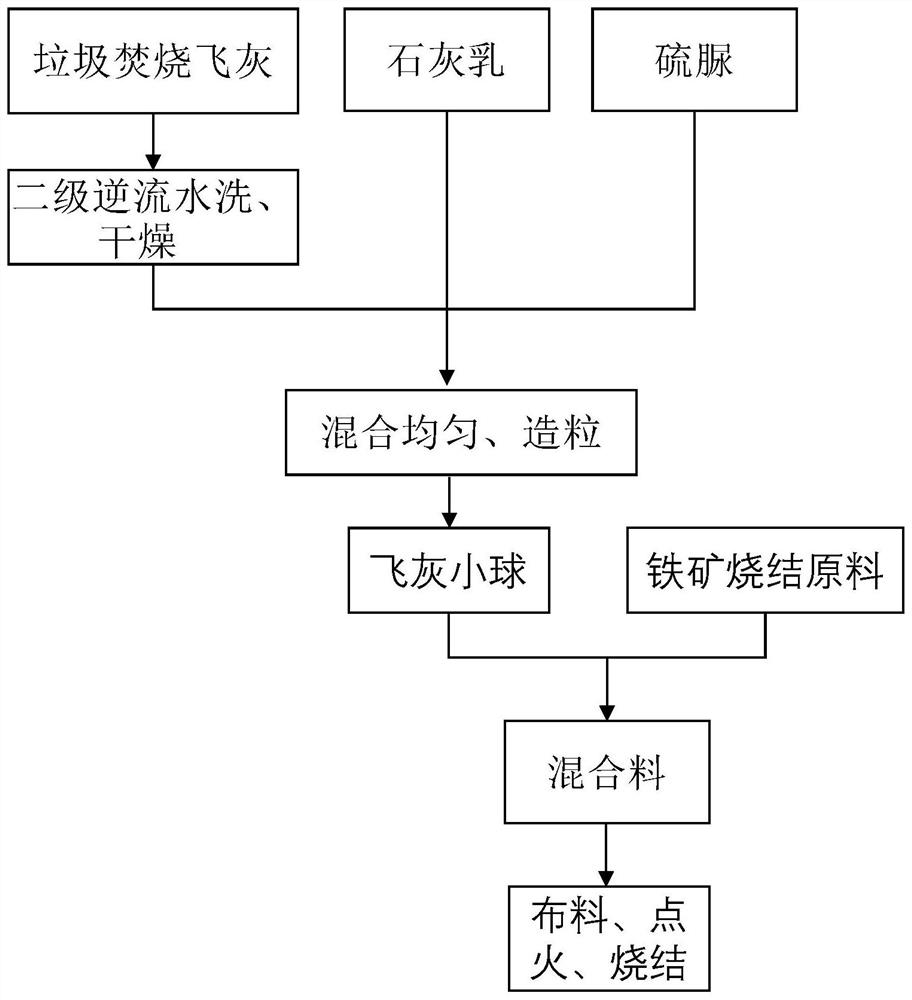Method for controlling dioxin in sintering co-treatment process of waste incineration fly ash
A technology for waste incineration fly ash and co-processing, applied in the field of fly ash disposal, can solve the problems of lack of resource utilization conditions, atmospheric air pollution, low fly ash addition, etc., to achieve resource utilization and efficient degradation. Effect
- Summary
- Abstract
- Description
- Claims
- Application Information
AI Technical Summary
Problems solved by technology
Method used
Image
Examples
Embodiment 1
[0044] The waste incineration fly ash is subjected to two-stage countercurrent washing, and the water-cement ratio is controlled to be 3:1. The washed waste incineration fly ash is press-filtered and dried at 100°C for 90 minutes (the chlorine content after washing is less than 0.5wt%, and the water content after drying is rate is less than 5%), and then mixed evenly with milk of lime and thiourea to make fly ash pellets with a particle size of 6mm, wherein milk of lime (calculated as CaO) accounts for 50% of the mass of fly ash pellets, and thiourea accounts for 0.1% of the quality of fly ash pellets; then the prepared fly ash pellets are mixed evenly with the iron ore sintering raw materials shown in Table 1 to obtain a mixture, the quality of fly ash pellets is 2% of the mass of iron ore sintering raw materials, and the obtained The mixed material is ignited and sintered after being clothed. The ignition temperature is controlled at 1100°C, the maximum sintering temperature ...
Embodiment 2
[0046] The waste incineration fly ash is subjected to two-stage countercurrent washing, and the water-cement ratio is controlled to be 3:1. The washed waste incineration fly ash is press-filtered and dried at 100°C for 90 minutes (the chlorine content after washing is less than 0.5wt%, and the water content after drying is rate is less than 5%), and then mixed evenly with milk of lime and thiourea to make fly ash pellets with a particle size of 6mm, wherein milk of lime (calculated as CaO) accounts for 50% of the mass of fly ash pellets, and thiourea accounts for 2.5% of the quality of fly ash pellets; then the prepared fly ash pellets are mixed evenly with the iron ore sintering raw materials shown in Table 1 to obtain a mixture, the quality of fly ash pellets is 3% of the quality of iron ore sintering raw materials, and the obtained The mixed material is ignited and sintered after being clothed. The ignition temperature is controlled at 1150°C, the maximum sintering temperatu...
Embodiment 3
[0048] The waste incineration fly ash is subjected to two-stage countercurrent washing, and the water-cement ratio is controlled to be 3:1. The washed waste incineration fly ash is press-filtered and dried at 100°C for 90 minutes (the chlorine content after washing is less than 0.5wt%, and the water content after drying is rate is less than 5%), and then mixed with milk of lime and thiourea to make fly ash pellets with a particle size of 6mm, wherein milk of lime (calculated as CaO) accounts for 66% of the mass of fly ash pellets, and thiourea accounts for 2.5% of the quality of fly ash pellets; then the prepared fly ash pellets are mixed evenly with the iron ore sintering raw materials shown in Table 1 to obtain a mixture, the quality of fly ash pellets is 3% of the quality of iron ore sintering raw materials, and the obtained The mixed material is ignited and sintered after being clothed. The ignition temperature is controlled at 1150°C, the maximum sintering temperature is 1...
PUM
| Property | Measurement | Unit |
|---|---|---|
| Granularity | aaaaa | aaaaa |
Abstract
Description
Claims
Application Information
 Login to View More
Login to View More - R&D
- Intellectual Property
- Life Sciences
- Materials
- Tech Scout
- Unparalleled Data Quality
- Higher Quality Content
- 60% Fewer Hallucinations
Browse by: Latest US Patents, China's latest patents, Technical Efficacy Thesaurus, Application Domain, Technology Topic, Popular Technical Reports.
© 2025 PatSnap. All rights reserved.Legal|Privacy policy|Modern Slavery Act Transparency Statement|Sitemap|About US| Contact US: help@patsnap.com



